SLUSBN5B August 2013 – July 2015 TPS53515
PRODUCTION DATA.
- 1 Features
- 2 Applications
- 3 Description
- 4 Revision History
- 5 Pin Configuration and Functions
- 6 Specifications
-
7 Detailed Description
- 7.1 Overview
- 7.2 Functional Block Diagram
- 7.3
Feature Description
- 7.3.1 5-V LDO and VREG Start-Up
- 7.3.2 Enable, Soft Start, and Mode Selection
- 7.3.3 Frequency Selection
- 7.3.4 D-CAP3 Control and Mode Selection
- 7.3.5 Power-Good
- 7.3.6 Current Sense and Overcurrent Protection
- 7.3.7 Overvoltage and Undervoltage Protection
- 7.3.8 Out-of-Bounds Operation
- 7.3.9 UVLO Protection
- 7.3.10 Thermal Shutdown
- 7.4 Device Functional Modes
- 8 Application and Implementation
- 9 Power Supply Recommendations
- 10Layout
- 11Device and Documentation Support
- 12Mechanical, Packaging, and Orderable Information
パッケージ・オプション
メカニカル・データ(パッケージ|ピン)
- RVE|28
サーマルパッド・メカニカル・データ
- RVE|28
発注情報
6 Specifications
6.1 Absolute Maximum Ratings(1)
over operating free-air temperature range (unless otherwise noted)| MIN | MAX | UNIT | |||
|---|---|---|---|---|---|
| Input voltage range(2) | EN | –0.3 | 7.7 | V | |
| SW | DC | –3 | 30 | ||
| Transient < 10 ns | –5 | 32 | |||
| VBST | –0.3 | 36 | |||
| VBST(3) | –0.3 | 6 | |||
| VBST when transient < 10 ns | 38 | ||||
| VDD | –0.3 | 28 | |||
| VIN | –0.3 | 30 | |||
| VO, FB, MODE, RF | –0.3 | 6 | |||
| Output voltage range | PGOOD | –0.3 | 7.7 | V | |
| VREG, TRIP | –0.3 | 6 | |||
| Junction temperature, TJ | –40 | 150 | °C | ||
| Storage temperature, Tstg | –55 | 150 | °C | ||
(1) Stresses beyond those listed under Absolute Maximum Ratings may cause permanent damage to the device. These are stress ratings only, which do not imply functional operation of the device at these or any other conditions beyond those indicated under Recommended Operating Conditions. Exposure to absolute-maximum-rated conditions for extended periods may affect device reliability.
(2) All voltages are with respect to network ground terminal.
(3) Voltage values are with respect to the SW terminal.
6.2 ESD Ratings
| VALUE | UNIT | |||
|---|---|---|---|---|
| V(ESD) | Electrostatic discharge | Human-body model (HBM), per ANSI/ESDA/JEDEC JS-001(1) | ±2500 | V |
| Charged-device model (CDM), per JEDEC specification JESD22-C101(2) | ±1500 | |||
(1) JEDEC document JEP155 states that 500-V HBM allows safe manufacturing with a standard ESD control process.
(2) JEDEC document JEP157 states that 250-V CDM allows safe manufacturing with a standard ESD control process.
6.3 Recommended Operating Conditions
over operating free-air temperature range (unless otherwise noted)| MIN | MAX | UNIT | ||
|---|---|---|---|---|
| Input voltage | EN | –0.1 | 7 | V |
| SW | –3 | 27 | ||
| VBST | –0.1 | 28 | ||
| VBST(1) | –0.1 | 5.5 | ||
| VDD | 4.5 | 25 | ||
| VIN | 1.5 | 18 | ||
| VO, FB, MODE, RF | –0.1 | 5.5 | ||
| Output voltage | PGOOD | –0.1 | 7 | V |
| VREG, TRIP | –0.1 | 5.5 | ||
| Operating free-air temperature, TA | –40 | 85 | °C | |
(1) Voltage values are with respect to the SW pin.
6.4 Thermal Information
| THERMAL METRIC(1) | TPS53515 | UNIT | |
|---|---|---|---|
| RVE (VQFN-CLIP) |
|||
| 28 PINS | |||
| RθJA | Junction-to-ambient thermal resistance | 37.5 | °C/W |
| RθJC(top) | Junction-to-case (top) thermal resistance | 34.1 | °C/W |
| RθJB | Junction-to-board thermal resistance | 18.1 | °C/W |
| ψJT | Junction-to-top characterization parameter | 1.8 | °C/W |
| ψJB | Junction-to-board characterization parameter | 18.1 | °C/W |
| RθJC(bot) | Junction-to-case (bottom) thermal resistance | 2.2 | °C/W |
(1) For more information about traditional and new thermal metrics, see the Semiconductor and IC Package Thermal Metrics application report, SPRA953.
6.5 Electrical Characteristics
over operating free-air temperature range, VREG = 5 V, EN = 5 V (unless otherwise noted)| PARAMETER | TEST CONDITIONS | MIN | TYP | MAX | UNIT | |
|---|---|---|---|---|---|---|
| SUPPLY CURRENT | ||||||
| IVDD | VDD bias current | TA = 25°C, No load Power conversion enabled (no switching) |
1350 | 1850 | µA | |
| IVDDSTBY | VDD standby current | TA = 25°C, No load Power conversion disabled |
850 | 1150 | µA | |
| IVIN(leak) | VIN leakage current | VEN = 0 V | 0.5 | µA | ||
| VREF OUTPUT | ||||||
| VVREF | Reference voltage | FB w/r/t GND, TA = 25°C | 597 | 600 | 603 | mV |
| VVREFTOL | Reference voltage tolerance | FB w/r/t GND, 0°C ≤ TJ ≤ 85°C | –0.6% | 0.5% | ||
| FB w/r/t GND, =–40°C ≤ TJ ≤ 85°C | –0.7% | 0.5% | ||||
| OUTPUT VOLTAGE | ||||||
| IFB | FB input current | VFB = 600 mV | 50 | 100 | nA | |
| IVODIS | VO discharge current | VVO = 0.5 V, Power Conversion Disabled | 10 | 12 | 15 | mA |
| SMPS FREQUENCY | ||||||
| fSW | VO switching frequency(2) | VIN = 12 V, VVO = 3.3 V, RDR < 0.041 | 250 | kHz | ||
| VIN = 12 V, VVO = 3.3 V, RDR = 0.096 | 300 | |||||
| VIN = 12 V, VVO = 3.3 V, RDR = 0.16 | 400 | |||||
| VIN = 12 V, VVO = 3.3 V, RDR = 0.229 | 500 | |||||
| VIN = 12 V, VVO = 3.3 V, RDR = 0.297 | 600 | |||||
| VIN = 12 V, VVO = 3.3 V, RDR = 0.375 | 750 | |||||
| VIN = 12 V, VVO = 3.3 V, RDR = 0.461 | 850 | |||||
| VIN = 12 V, VVO = 3.3 V, RDR > 0.557 | 1000 | |||||
| tON(min) | Minimum on-time | TA = 25°C(1) | 60 | ns | ||
| tOFF(min) | Minimum off-time | TA = 25°C | 175 | 240 | 310 | ns |
| INTERNAL BOOTSTRAP SW | ||||||
| VF | Forward Voltage | VVREG–VBST, TA = 25°C, IF = 10 mA | 0.15 | 0.25 | V | |
| IVBST | VBST leakage current | TA = 25°C, VVBST = 33 V, VSW = 28 V | 0.01 | 1.5 | µA | |
| LOGIC THRESHOLD | ||||||
| VENH | EN enable threshold voltage | 1.3 | 1.4 | 1.5 | V | |
| VENL | EN disable threshold voltage | 1.1 | 1.2 | 1.3 | V | |
| VENHYST | EN hysteresis voltage | 0.22 | V | |||
| VENLEAK | EN input leakage current | –1 | 0 | 1 | µA | |
| SOFT START | ||||||
| tSS | Soft-start time | 1 | ms | |||
| PGOOD COMPARATOR | ||||||
| VPGTH | VDDQ PGOOD threshold | PGOOD in from higher | 104% | 108% | 111% | |
| PGOOD in from lower | 89% | 92% | 96% | |||
| PGOOD out to higher | 113% | 116% | 120% | |||
| PGOOD out to lower | 80% | 84% | 87% | |||
| IPG | PGOOD sink current | VPGOOD = 0.5 V | 4 | 6 | mA | |
| tPGDLY | PGOOD delay time | Delay for PGOOD going in | 0.8 | 1.0 | 1.2 | ms |
| Delay for PGOOD coming out | 2 | µs | ||||
| IPGLK | PGOOD leakage current | VPGOOD = 5 V | –1 | 0 | 1 | µA |
| CURRENT DETECTION | ||||||
| RTRIP | TRIP pin resistance range | 20 | 70 | kΩ | ||
| IOCL | Current limit threshold, valley | RTRIP = 52.3 kΩ | 10.1 | 12 | 13.9 | A |
| RTRIP = 38 kΩ | 7.2 | 9.1 | 11.0 | |||
| IOCLN | Negative current limit threshold, valley | RTRIP = 52.3 kΩ | –15.3 | –11.9 | –8.5 | A |
| RTRIP = 38 kΩ | –12 | –9 | –6 | |||
| VZC | Zero cross detection offset | 0 | mV | |||
| PROTECTIONS | ||||||
| VVREGUVLO | VREG undervoltage-lockout (UVLO) threshold voltage | Wake-up | 3.25 | 3.34 | 3.41 | V |
| Shutdown | 3.00 | 3.12 | 3.19 | |||
| VVDDUVLO | VDD UVLO threshold voltage | Wake-up (default) | 4.15 | 4.25 | 4.35 | V |
| Shutdown | 3.95 | 4.05 | 4.15 | |||
| VOVP | Overvoltage-protection (OVP) threshold voltage | OVP detect voltage | 116% | 120% | 124% | |
| tOVPDLY | OVP propagation delay | With 100-mV overdrive | 300 | ns | ||
| VUVP | Undervoltage-protection (UVP) threshold voltage | UVP detect voltage | 64% | 68% | 71% | |
| tUVPDLY | UVP delay | UVP filter delay | 1 | ms | ||
| THERMAL SHUTDOWN | ||||||
| TSDN | Thermal shutdown threshold(1) | Shutdown temperature | 140 | °C | ||
| Hysteresis | 40 | |||||
| LDO VOLTAGE | ||||||
| VREG | LDO output voltage | VIN = 12 V, ILOAD = 10 mA | 4.65 | 5 | 5.45 | V |
| VDOVREG | LDO low droop drop-out voltage | VIN = 4.5 V, ILOAD = 30 mA, TA = 25°C | 365 | mV | ||
| ILDOMAX | LDO overcurrent limit | VIN = 12 V, TA = 25°C | 170 | 200 | mA | |
| INTERNAL MOSFETS | ||||||
| RDS(on)H | High-side MOSFET on-resistance | TA = 25°C | 13.8 | 15.5 | mΩ | |
| RDS(on)L | Low-side MOSFET on-resistance | TA = 25°C | 5.9 | 7.0 | mΩ | |
(1) Specified by design. Not production tested.
(2) Resistor divider ratio (RDR) is described in Equation 1.
6.6 Typical Characteristics
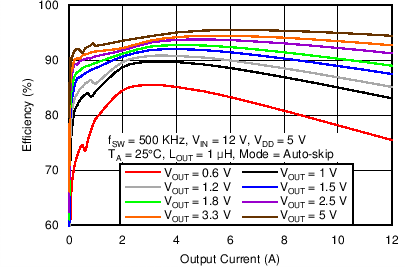
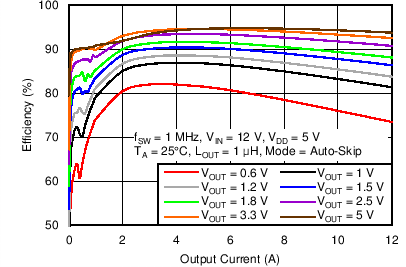
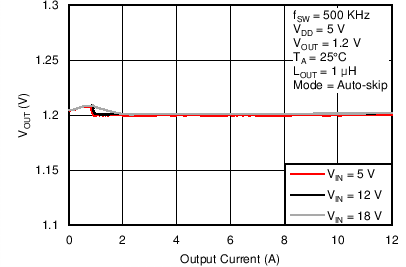
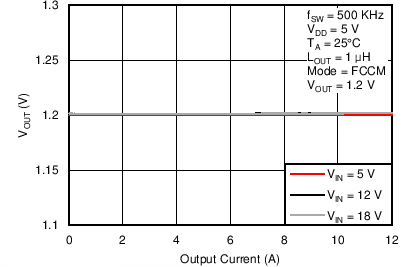
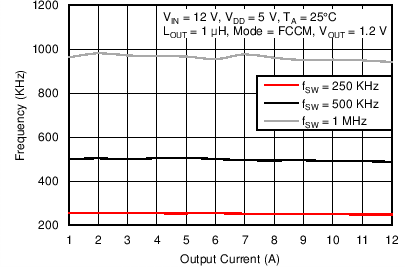
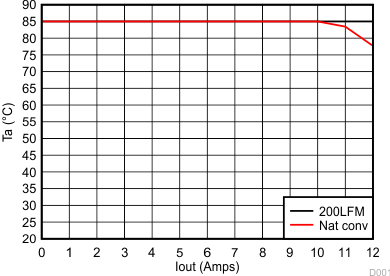
| VIN = 12 V | Switching frequency = 600kHz | |
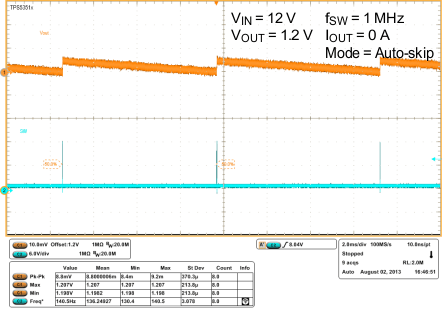
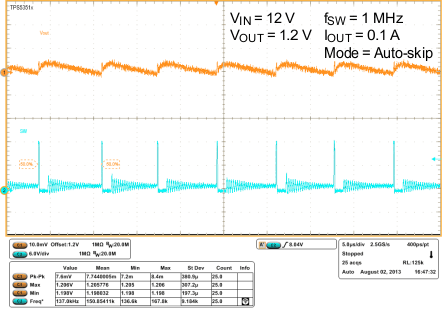
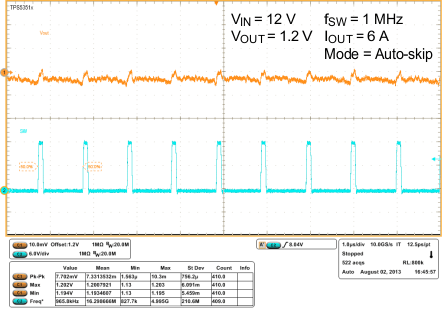
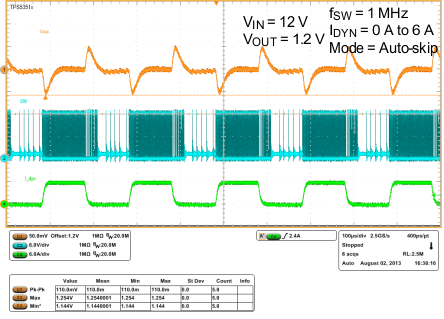
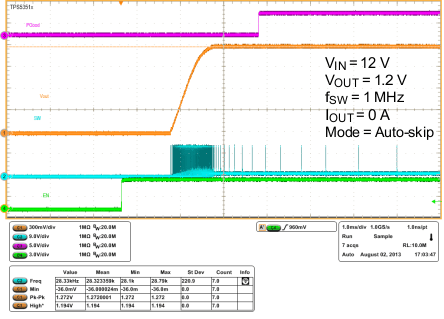
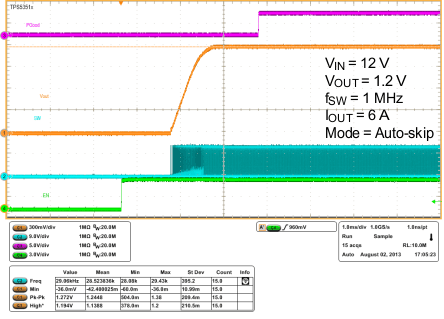
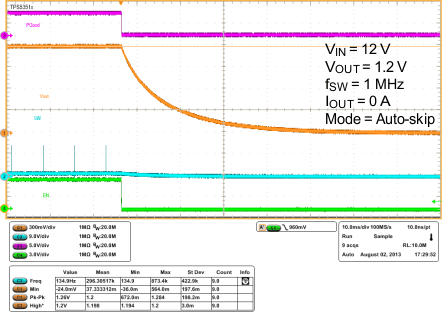
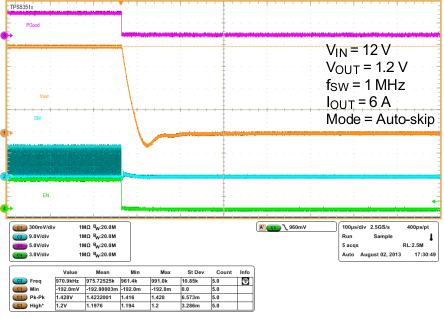
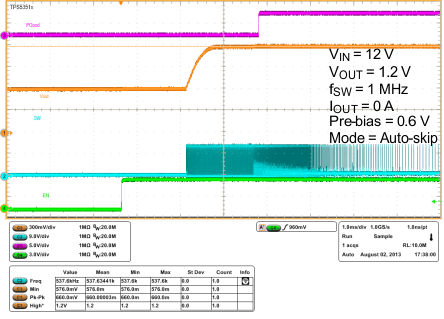
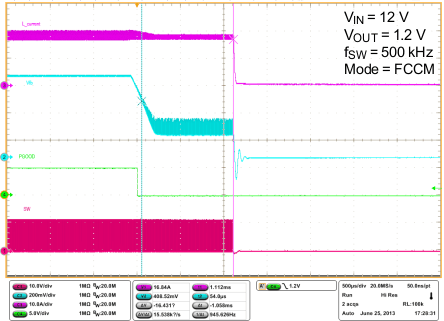
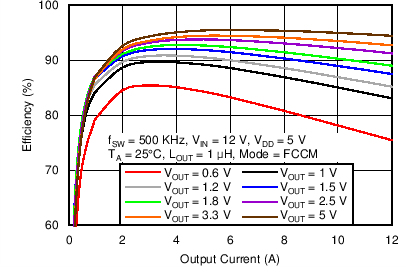
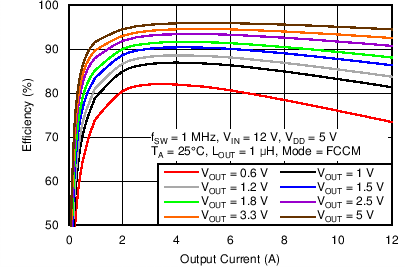
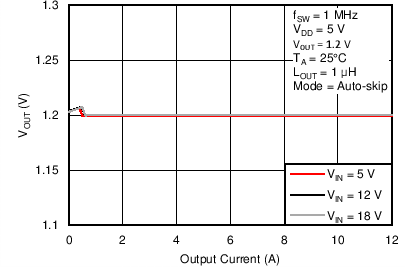
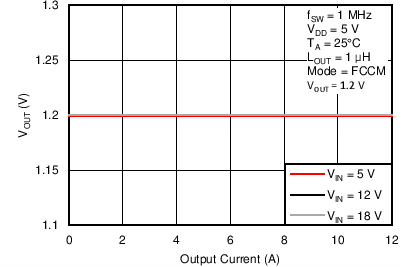
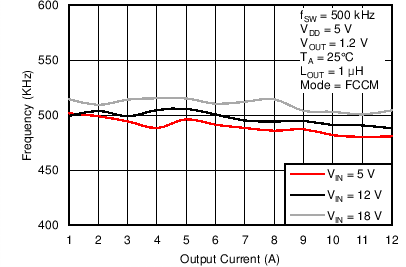
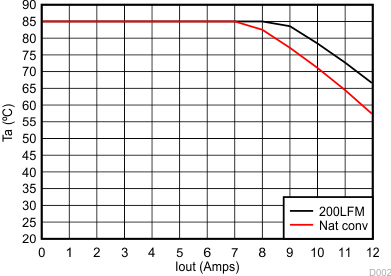
| VIN = 12 V | Switching frequency = 600kHz | |
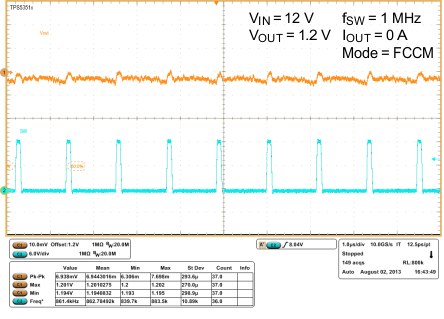
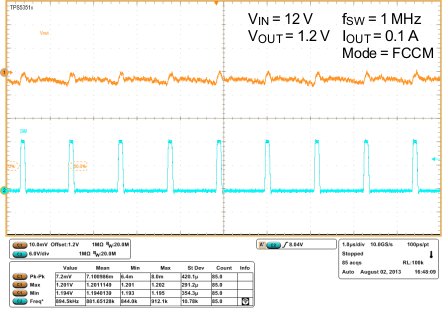
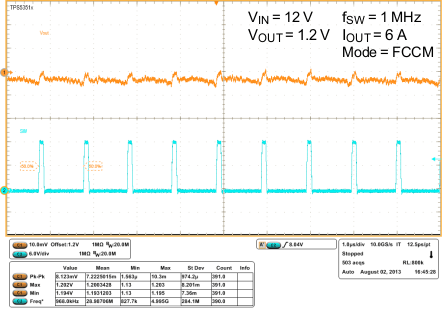
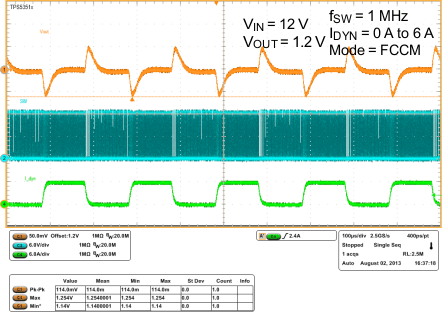
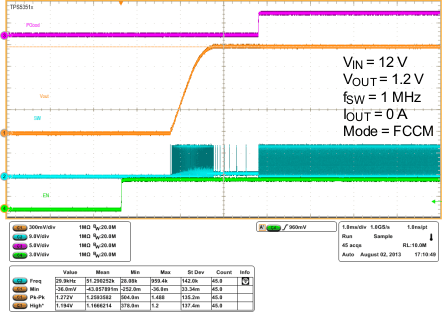
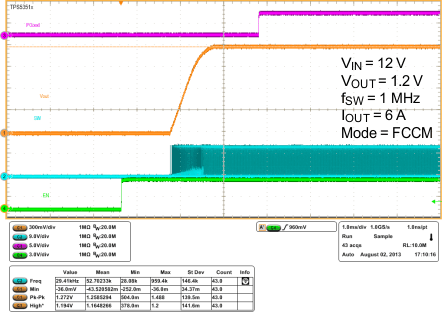
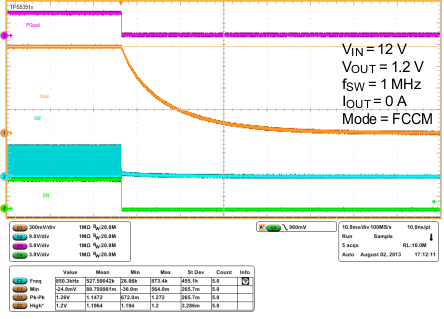
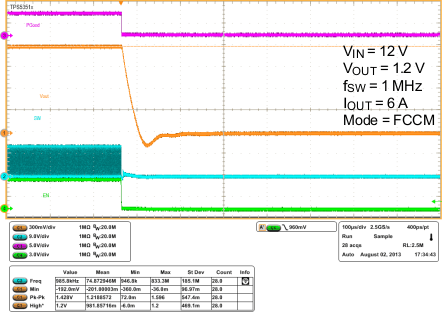
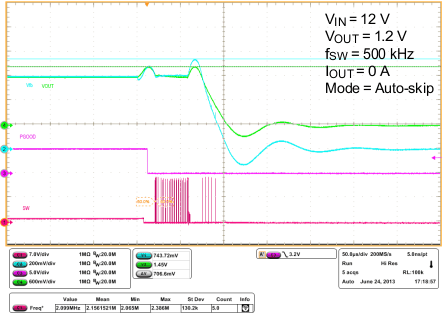
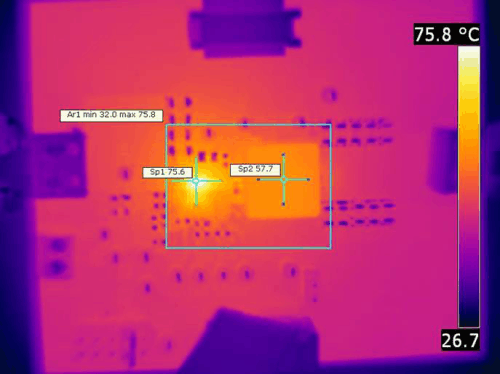
| fSW = 500 kHz | VI = 12 V | VO = 5 V |
| IO = 12 A | COUT= 10 x 22 µF | ( 1206, 6.3 V, X5R) |
| SNB = 3 Ω+ 470 pF | RBOOT= 0 Ω | |
| Inductor: | LOUT = 1 µH | 2.1 mΩ (typ) |
| PCMC135T-1R0MF | 12.6 mm × 13.8 mm × 5 mm | |